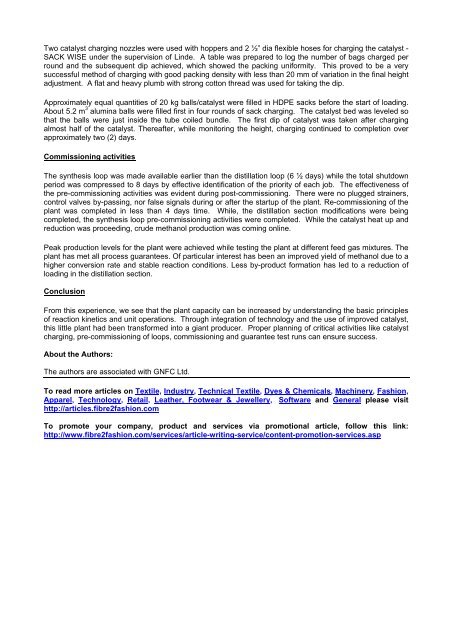Methanol Plant Capacity Enhancement By: Mr. C D ... - Fibre2fashion
Methanol Plant Capacity Enhancement By: Mr. C D ... - Fibre2fashion
Methanol Plant Capacity Enhancement By: Mr. C D ... - Fibre2fashion
You also want an ePaper? Increase the reach of your titles
YUMPU automatically turns print PDFs into web optimized ePapers that Google loves.
Two catalyst charging nozzles were used with hoppers and 2 ½” dia flexible hoses for charging the catalyst -<br />
SACK WISE under the supervision of Linde. A table was prepared to log the number of bags charged per<br />
round and the subsequent dip achieved, which showed the packing uniformity. This proved to be a very<br />
successful method of charging with good packing density with less than 20 mm of variation in the final height<br />
adjustment. A flat and heavy plumb with strong cotton thread was used for taking the dip.<br />
Approximately equal quantities of 20 kg balls/catalyst were filled in HDPE sacks before the start of loading.<br />
About 5.2 m 3 alumina balls were filled first in four rounds of sack charging. The catalyst bed was leveled so<br />
that the balls were just inside the tube coiled bundle. The first dip of catalyst was taken after charging<br />
almost half of the catalyst. Thereafter, while monitoring the height, charging continued to completion over<br />
approximately two (2) days.<br />
Commissioning activities<br />
The synthesis loop was made available earlier than the distillation loop (6 ½ days) while the total shutdown<br />
period was compressed to 8 days by effective identification of the priority of each job. The effectiveness of<br />
the pre-commissioning activities was evident during post-commissioning. There were no plugged strainers,<br />
control valves by-passing, nor false signals during or after the startup of the plant. Re-commissioning of the<br />
plant was completed in less than 4 days time. While, the distillation section modifications were being<br />
completed, the synthesis loop pre-commissioning activities were completed. While the catalyst heat up and<br />
reduction was proceeding, crude methanol production was coming online.<br />
Peak production levels for the plant were achieved while testing the plant at different feed gas mixtures. The<br />
plant has met all process guarantees. Of particular interest has been an improved yield of methanol due to a<br />
higher conversion rate and stable reaction conditions. Less by-product formation has led to a reduction of<br />
loading in the distillation section.<br />
Conclusion<br />
From this experience, we see that the plant capacity can be increased by understanding the basic principles<br />
of reaction kinetics and unit operations. Through integration of technology and the use of improved catalyst,<br />
this little plant had been transformed into a giant producer. Proper planning of critical activities like catalyst<br />
charging, pre-commissioning of loops, commissioning and guarantee test runs can ensure success.<br />
About the Authors:<br />
The authors are associated with GNFC Ltd.<br />
To read more articles on Textile, Industry, Technical Textile, Dyes & Chemicals, Machinery, Fashion,<br />
Apparel, Technology, Retail, Leather, Footwear & Jewellery, Software and General please visit<br />
http://articles.fibre2fashion.com<br />
To promote your company, product and services via promotional article, follow this link:<br />
http://www.fibre2fashion.com/services/article-writing-service/content-promotion-services.asp

















